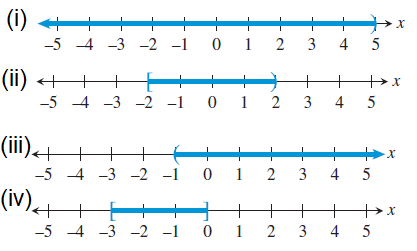BOUNDED AND UNBOUNDED INTERVALS
Interval of finite length is called bounded interval.
Interval of infinite length is called unbounded interval.
Closed interval :
The closed interval will contain endpoints. We use square bracket [ to use closed interval.
For example,
[2 , 7]
Endpoints are 2 and 7, possible integer values are 2, 3, 4, 5, 6, 7.
Open interval :
The open interval will not contain endpoints. We use bracket ( to use open interval.
For example,
(2 , 7)
Possible integers are 3, 4, 5, 6.
Half open interval :
Will contain one closed bracket and another open bracket .
For example,
[2 , 7)
Possible integers are 2, 3, 4, 5, 6.
For example,
(2 , 7)]
Possible integers are 3, 4, 5, 6, 7.
Problem 1 :
Convert interval notation to inequality notation or vice versa. Find the endpoints and state whether the interval is bounded, its type, and graph the interval.
(a) [-6, 3)
(b) (-∞, -1)
(c) -2 ≤ x ≤ 3
Solution :
(a) It has endpoints -6 and 3.
Inequality Notation :
The possible values are -6 ≤ x < 3.
Graph :

Type of interval :
It is bounded.
(b) (-∞, -1)
Endpoints :
It has the endpoint -1.
Inequality Notation :
The possible values are x < -1.
Graph :

Type of interval :
It is unbounded.
(c) -2 ≤ x ≤ 3
Endpoints :
-2 and 3 are the endpoints.
Inequality Notation :
The possible values are -2 ≤ x ≤ 3.
Graph :

Type of interval :
It is bounded.
Problem 2 :
Describe and graph the interval of real numbers.
(i) x ≤ 2
(ii) -2 ≤ x < 5
Solution :


Problem 3 :
Write the following as interval notation :
(i) (-∞, 7)
(ii) [-3, 3]
(iii) x is negative
(iv) x is greater than or equal to 2 and less than or equal to 6.
Solution :
(i) (-∞, 7) ==> -∞< x < 7
(ii) [-3, 3] ==> -3 ≤ x ≤ 3
(iii) x is negative ==> x < 0
(iv) x is greater than or equal to 2 and less than or equal to 6.
x ≥ 2 and x ≤ 6
Problem 4 :

Solution :
(i) (-∞, 5)
(ii) [-2, 2)
(iii) (-1,∞)
(iv) [-3, 0]
Problem 5 :
Convert to inequality notation. Find the endpoints and state whether the interval is bounded or unbounded and its type.
(i) (-3, 4]
(ii) (-3, -1)
(iii) (-∞, 5)
(iv) [-6, ∞)
Solution :
(i) (-3, 4]
Inequality notation :
-3 < x ≤ 4
Endpoints :
-3 and 4 are endpoints.
Bounded : Half open
(ii) (-3, -1)
Inequality notation :
-3 < x < -1
Endpoints :
-3 and -1 are endpoints.
Bounded: Open
(iii) (-∞, 5)
Inequality notation :
x < 5
Endpoints :
End point is 5.
Unbounded : Open
(iv) [-6, ∞)
Inequality notation :
-6 < x < ∞
Endpoints :
Endpoint is -6
Unbounded : Half open
Recent Articles
-
Finding Range of Values Inequality Problems
May 21, 24 08:51 PM
Finding Range of Values Inequality Problems -
Solving Two Step Inequality Word Problems
May 21, 24 08:51 AM
Solving Two Step Inequality Word Problems -
Exponential Function Context and Data Modeling
May 20, 24 10:45 PM
Exponential Function Context and Data Modeling